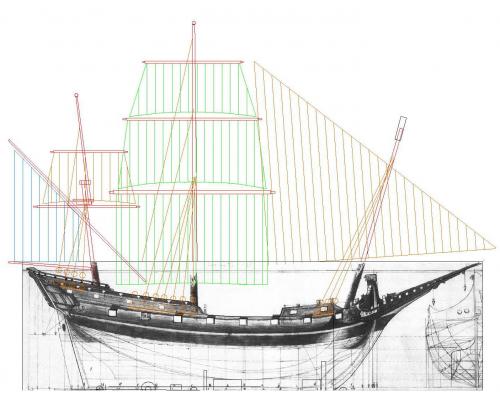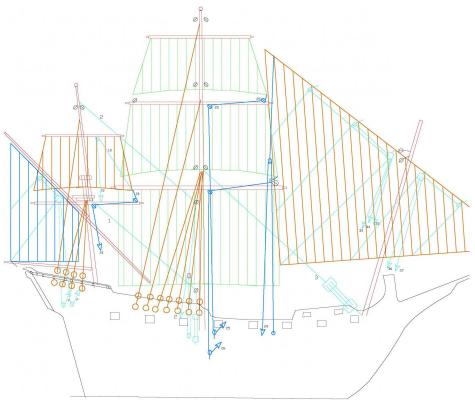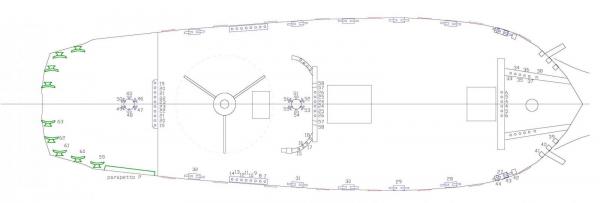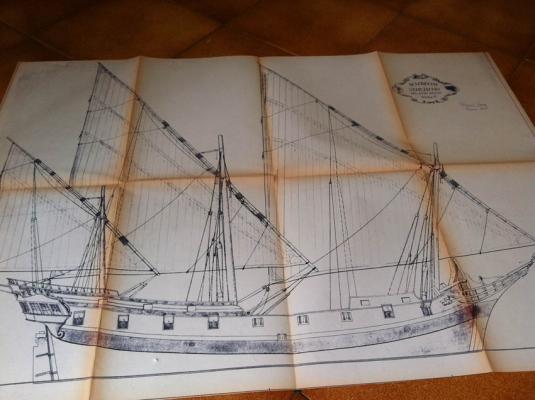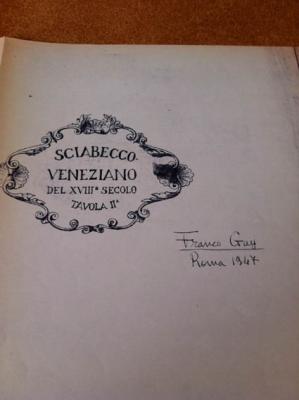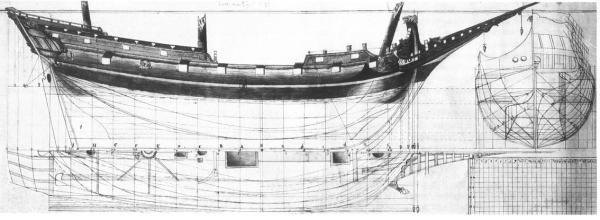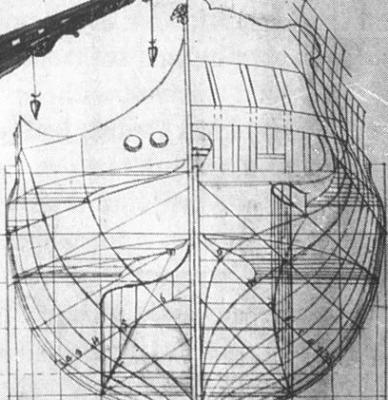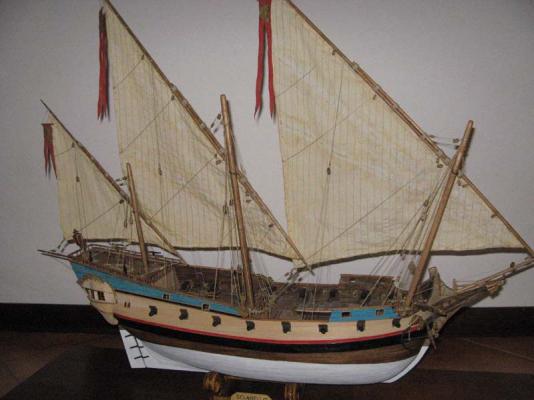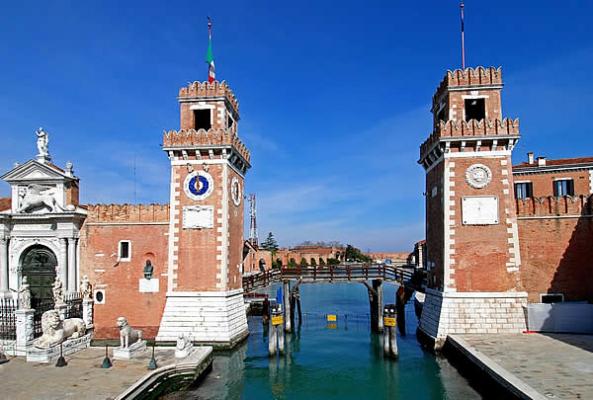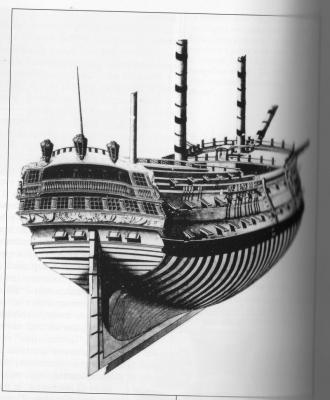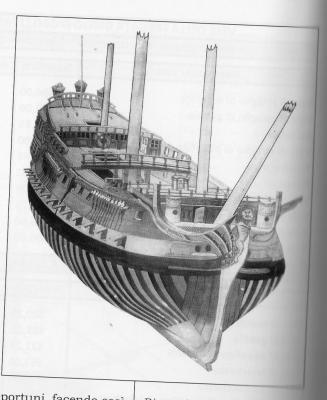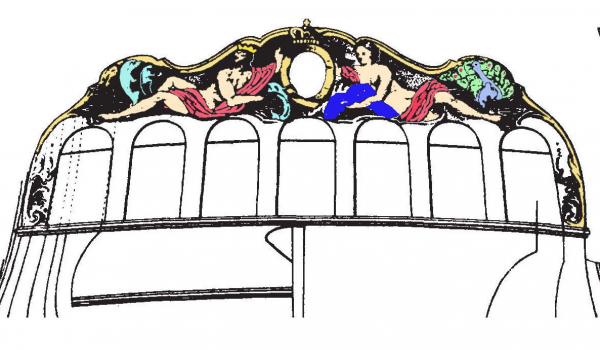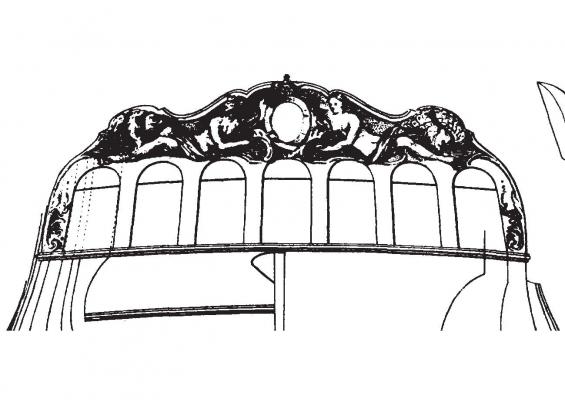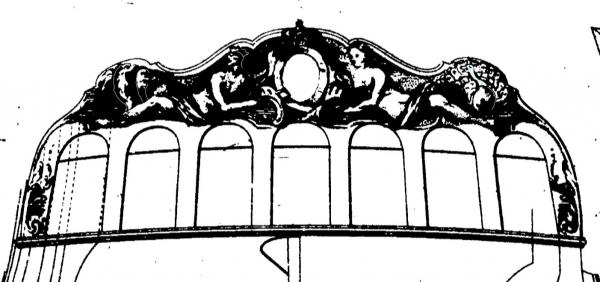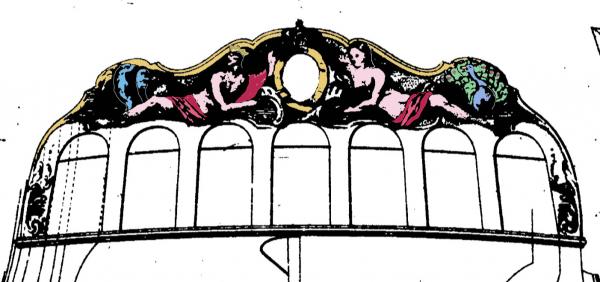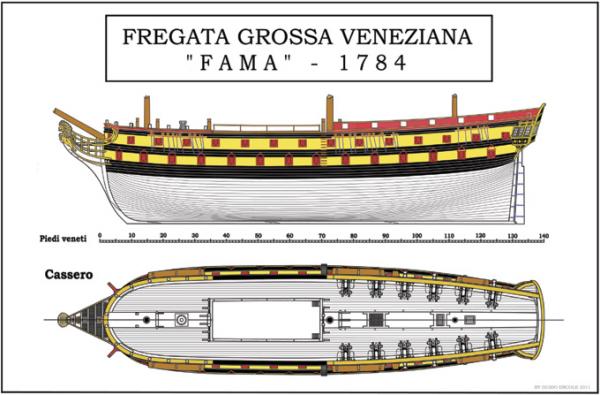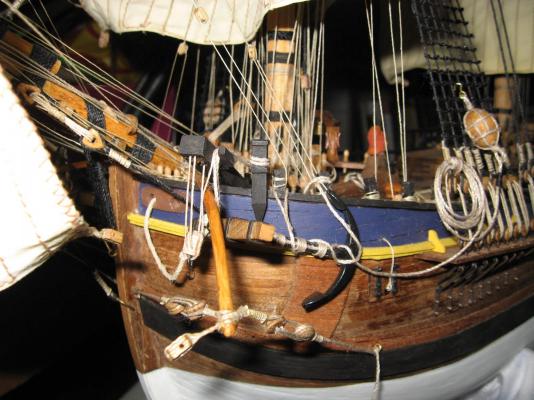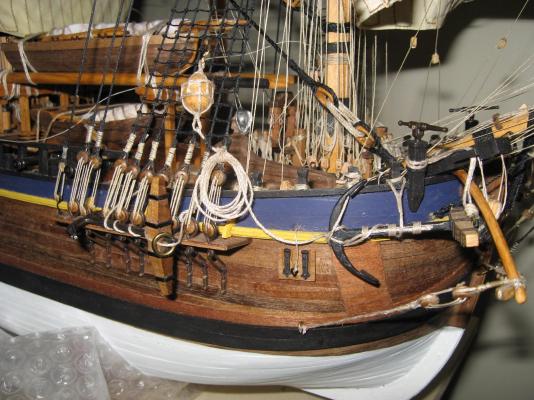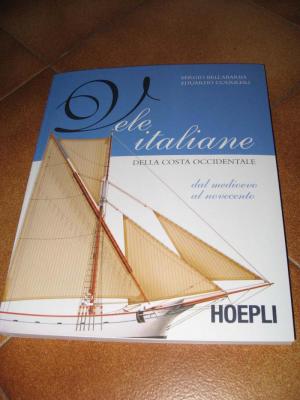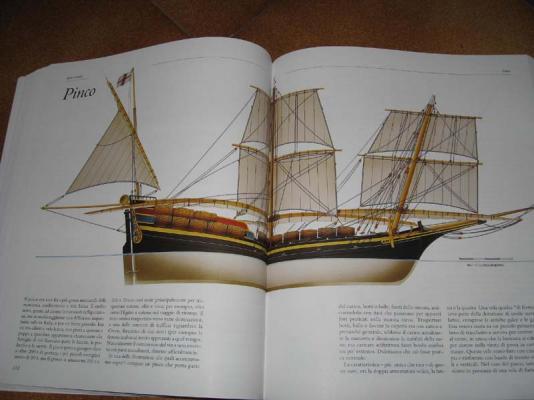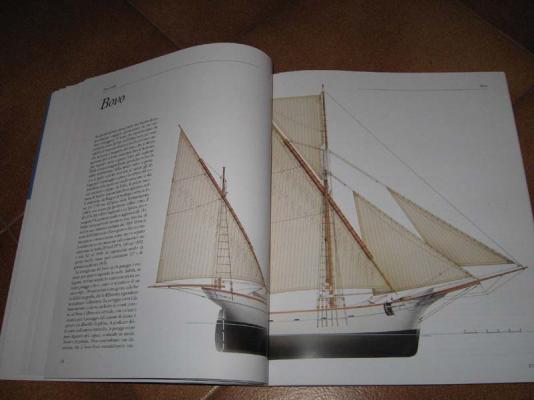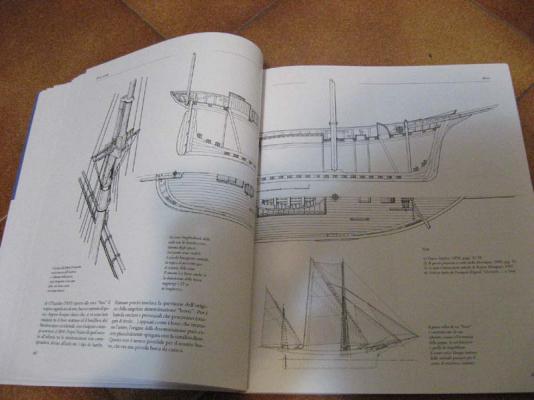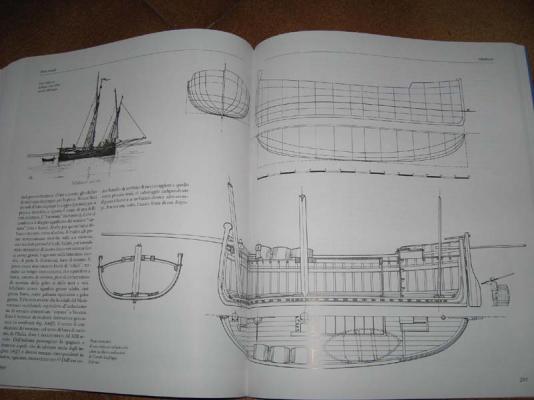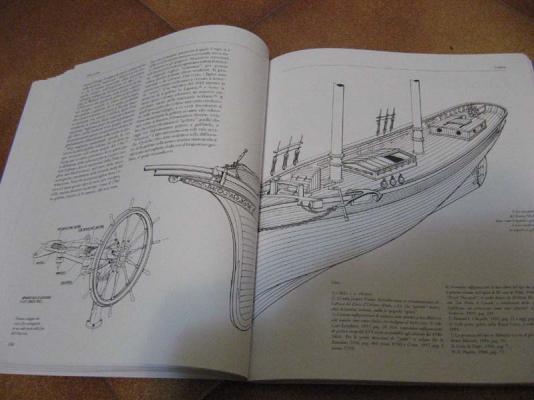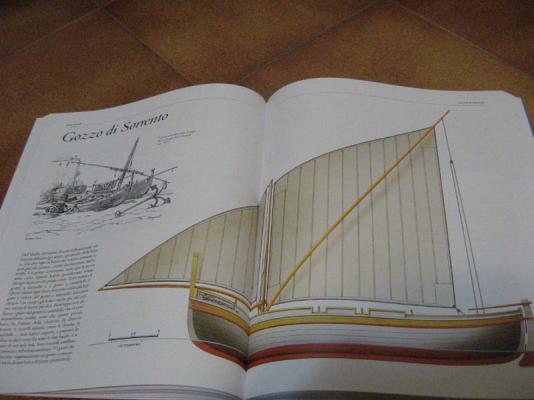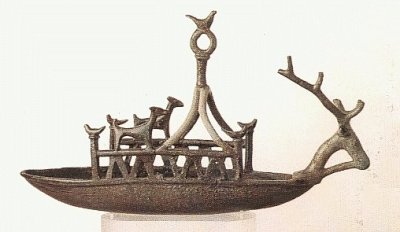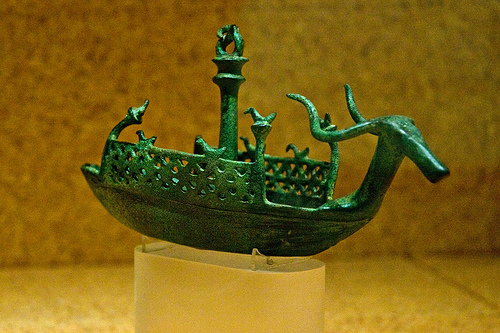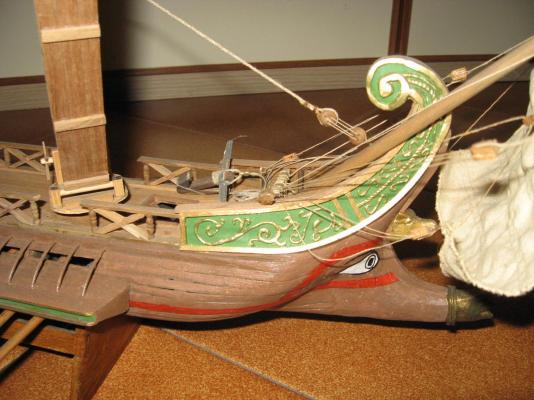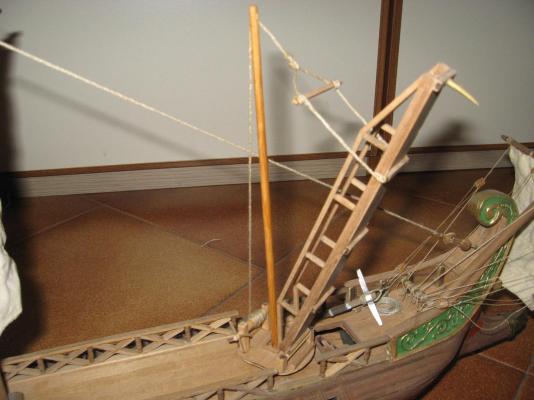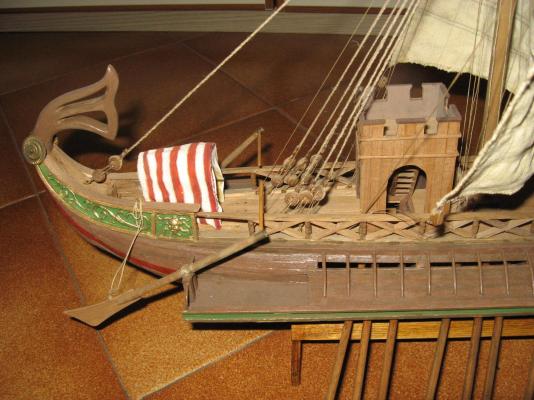-
Posts
423 -
Joined
-
Last visited
Content Type
Profiles
Forums
Gallery
Events
Everything posted by Cristiano
-
THE SAIL PLAN After evaluating the historical period and other similar projects, I decided that the sail plan can be rather similar to the one made by Amati Venetian Polacre. Other plans exist of other polacres of other countries, and the sail size are all more or less the same. below can be seen some of the sail plans and rigging that I made with a CAD program. I superimposed the orignal hull drawing. The rigging is a rather complex part. In the photos only few of the rigging that I made is showed. Luckily, in the mid XVIII century the sail rigging was rather standardised, so I must not make too much odd hypotesis. Note: I mirrored the top view of the hull, and evenly corrected, the drawing is still not correct. So it means that the original drawing was probably focused on the hull drawing and only lighty on the bridges details.
-
More than 20 years ago I built from scratch a venetian xebec, from purchased plans. The plans are available but are not made by the usual ships manufacturers. They were made accordingly to original drawings coming from a Venetian archive. In the photos can be seen some of the plans and the model that I made. The model is rather big (around 90 cm long). I always been puzzled by the strange shape of such xebec (a bit fat, hull not common on xebec). Now finally I have found the original ancient drawings that originated such plans! They are published in the book "Venetian Ships - Navi Veneziane" by Gilberto Penzo, Lint editor. I discovered that the ship was a polacre, and the absence of sail plan probably generated some misunderstanding on the author of the plans thay I purchased. The original drawings were a bit different and the typical polacre hull is more evident. After that I decided to study a deep conversion of the model, in order to let it be more similar to the original one. in the photos: -one of the purchased plans, made in 1947 (first two photos). -the original drawings (second two photos) -the present model. Well, I am not a true expert, but the final result will be less historically false than the present one, so in anycase will be a success for me! Any critics to the project (even destructive critics!) and suggestions are always appreciated!
-
Is up to you, but consider that La Harpe has never sailed under venetian flag. Came out from the Arsenale with French flag (and French name). It was projected for 74 cannons but the French armed it with 70 cannons (28 of 25 french lb., 28 of 18 french lb, 14 of 8 french lb.) I have not evidences that it was armed with 74 cannons. Its life was very short and not so glorious (see my previous post). So, are you sure that you want to build a ship with such sad history? The "Leon Trionfante" parteciped to many naval battles and ended its life naturally after 24 years. It can be considered at least a piece of Venetian history. But I know that you are focused on a different historic period and the Leon Trionfante came out from shipyard on 1716 (too early probably for your desired period of time)
-
The biggest ships that sailed under the Venetian flag were probably the "Leon Trionfante" class. They had 70 cannons. The limit was not the technical knowledge of the Venetian engineers, but their...lagoon. Since the lagoon has low depth, was not possible to maintain adeguately large ships. In addition the "overprotected" Venetian shipyard (The Arsenale) entrance has a width limit for the passage of ships (see the attached photo, where now there is a bridge). For the depth, the "camels" where used, but for the width...no solutions! The first one, the "Leon Trionfante" that gave the name to the class, was a successful project and generated many ships. Technically you can find several drawings of it in the book: -page 107 and 142: complete drawings of the hull; -page 170:stern prospective view (see photo); -page 180: bow prospective view (see photo); -page 182: sail plans of the leon trionfante class. -page 242/243: complete hystory, cannon types, number and size and all the lenghts -pag. 155: colours of those type of ships. There are complete drawings available of "Aquila Valiera", again of 70 cannons, but an older type of ship. The complete drawings unfortunately are in the other book: "Duri i banchi!"
-
Hello, theoretically yes. not all the Venetian ships arrived in the hands of the Austro-hungarians, only few. Many remained under the French flag in Tolone or Corfù. The Austro-hungarian take control of the Venetian ships that they found in the cities that they conquered. La Harpe was captured by the Austro-hungarian in 1799 because it was anchored in Ancona when they conquered the city. But it was judged in bad conditions and sent to Venezia for repairs. In 1802, when it was still under repairs, it was converted in "floating jail" and anchored in Venice. Well, to be clear, it sailed under the Austrian flag only for the travel from Ancona to Venice... La Harpe was a "1780" class, not a "Fama" class. The last of the "Fama" class were Le Stengel and Le Beyrand. But again, both those above ships, even in the hands of Austro-Hungarians, more or less never sailed under Austrian flag. Le Stengel: was captured near Ancona in 1799 and send later to Venice for urgent repair (the only travel done with austrian-hungarian flag). It arrived in Venice half-sinked and was converted in a pontoon. in 1804 the pontoon sinked completely. was keep floating again in 1805 and converted in floating cannon battery. then again converted in pontoon by second French occupation. in 1814 was demolished. Le Beyrand: after few campaigns under French flags, was converted in 1799 in floating cannon battery and anchored in Ancona. the same year the ship was found sinked by the Austrian when conquered Ancona. on summer 1800 was keep floating again and sent to Venezia. It was demolished in 1803, but probably was used as a pontoon in those years. If you need more informations, let me know. The Venice ships under austrian and french domination changed name and flag many times in few years, and were not maintained properly. The largest part of the Venetian fleet was destroyed methodically by the French soldiers when still anchored or in the shipyard, when they conquered Venice. The Napoleon fury was a political signal, to punish the Venetians for not having supported him against Austro-hungarian empire. So few ships remained intact after that methodic destruction. When the French naval engineers arrived to Venice for evaluating the ships to be incorporated in the French fleet, it was almost too late, since the largest part were destroyed. The one that was largerly saved was the Venetian fleet of Corfù. So the net result of above considerations is that the Austro-hungarian empire has not taken many ships, but very very few.
-
I suppose that the book not available is "duri i banchi!", which was focused on galleys. There is still one very "precious" book that you should try to find: "NAVI VENEZIANE - VENETIAN SHIPS" by Gilberto Penzo. LINT editor. It is a book rather hard to find but: -it is the most complete collection of original ships plans of all the venetian war ships made by the Venetian Republic. Are all original drawings (mostly construction plans), coming from various different sources and collections. 223 drawings of ships of various size, from xebec, galleys, to polacre to ship of the line. I bought it through Amazon, since IBS failed to find it from the editor. below the link: http://www.amazon.it/Navi-veneziane-Venetian-ships-Gilberto-Penzo/dp/888190103X/ref=sr_1_2?ie=UTF8&qid=1402080103&sr=8-2&keywords=navi+veneziane Not all the drawings are provided with dates or explanations written on it, so an historical background is needed in order to evaluate correctly some plan. below the link in the author website: http://www.veniceboats.com/it-pubblicazioni-catalogo-libri-navi-ven.htm technically you can buy it from the author too, but it is better to send an email to him asking for availability. When the Venice Republic collapsed against Napoleon, the largest part of the drawings were dispersed, razed, destroyed, sold. So this book represent the only way to have the plans all together.
-
Hello Dick, you are doing a marvellous work. I discovered your "shipyard" very late. If you are looking for some additional material (scarce) in the web, I suggest to search using the old venetian term used for the carrack: the ancient Italians didn't use the term carrack or "caracca" for this type of merchant ship. They used the term "nave tonda" (mainly the venetians) or "cocca". So all the ancient documents in Italian language refers always to "navi tonde" and so the paintings. The man in the below link should be looked closely, since it is one of the main hystorical experts of ancient venetian ships. it is a ship modeller, too! below the link of its own "nave tonda" model (nearly missed by Steven ): http://www.veniceboats.com/it-modelli-navi-antiche.htm and below the link to the project plans, on which you will find a "nave tonda" (the first one) http://www.veniceboats.com/it-progetti-piani-navi-grosse.htm maybe something can be still of interest for you, even if it is too late.
-
Hello Maris Stella, Feel free to ask if you have some troubles on translating the books or have some question that can answer! there is this additional book eventually, which is related generically on the mediterranean galleys. As the previous ones, is full of drawings. It Is of the same editor: http://www.ibs.it/code/9788890251146/ercole-guido/galee-mediterranee-5000.html I didn't buy it because I think there is an overlap of informations with the other book of the galleys "Duri i banchi!". The problem of the book "Duri i banchi!" is that now has limited availabily and can delay the expedition of the other one, too. But if they have trouble on finding it, they will remove it from the order or they ask to you if you want that they send the other one even alone. Well, if you want to have a complete range of small traditional mediterranean boat projects, there is also the following: http://www.ibs.it/code/9788820348335/bellabarba-sergio-guerrieri-edoardo/vele-italiane-della-costa.html I made a brief review there: http://modelshipworld.com/index.php?/topic/6156-vele-italiane-della-costa-occidentale/ It is hard to find valuable books related to the mediterranean ships history, so when I find some I always suggest them!
-
Hello Mike, My evaluation is done considering the typical positions and actions of the decorating figures typical of the stern of the ships of those period. So the answers IMHO are: -they are resting on nothing, since usually there were not pieces of forniture or ambient on those decorations; -one hand of both the gods probably is touching the porthole; -the other hand is doing something, since usually always a figure do something, like indicating with fingers an object or handling an object. -Poseidon has one hand near the third fish. -Hera IMHO hold an object (I coloured it BRIGHT BLUE in the below image), that cover partially her body and fingers. I think it can be a vase pouring water or a cornucopia pouring goods, but it is just a thought. But beware! Chapman was a naval architect, so it was focused on drawing the hull of the ships. The drawings of decorations was not of main interest for him, so maybe some detail can not exist at all, because he maybe has draw only a draft of the stern decoration. Since the symbols related to Hera ended with the peacock, the object she is holding depends by the author of the decoration, so it can be flowers, cornucopia, vase. Well, with the above considerations I ended any possible additional informations that I can produce, at least without starting to flying to much with fantasy.
-
Hello Mike, I completed my hypotesis of the stern of the Unicorn. Now the bodies are better defined. I know that it is pretty useless to focus on such details, but that "mistery" intrigued me! So I didn't want to leave the work unfinished. In addition, I am working for myself, too, since the Unicorn lays packed on a my shelf. I think the fishes (dolphins ?) are three (coloured in cyan). It remains unsolved what is holding Hera. She is holding "something that is spilling something", like a vase spilling water or a cornucopia spilling goods. It is not surely a part of the clothes. As said, this is my thought, not an absolute certainty!
-
Hello, As I can see, in the suggeted book "vascelli e fregate della Serenissima" you can find a lot of drawings for making a "Leon Trionfante" class ship of the line, which owned around 66 cannons and dated 1793 (including hull drawings). The above one has front and rear original perspective drawings, too. In addition many drawing (hull included) for various classes. There is also the complete list of the ship manufactured by the Venezia Shipyard and the hystory of each ship. There is another book, focused mainly on galleys, but it has the complete drawings of the "Aquila Valiera", which was an admiral ship of 70 cannons, dated 1698 (including hull drawings). below the link: http://www.ibs.it/code/9788890251108/ercole-guido-zzz99-chist-e/duri-i-banchi-le.html in the above book you will find plenty of drawings of galleys and xebec. So, before doing everything, it should be better for you to purchase the above mentioned books (the second one is more hard to find). Are Italian written, but I can help you.
-
Hello Mike, glad to help you, if I can. Below the stern. I added colours, in order to exalt the differences in the various figures, but the colours are just to exalt the figures. The jumping fishes (two or one?) on left should be dolphins, since a dolphin was a symbol of Poseidon. I "completed" some line, in order to show better the figures. So, basically the stern represent two mitological gods and their related symbols...
-
Hello Mike, my though regarding the stern: the crowned man on the left should be Poseidon, the god of sea. Theirs symbols should be three (or two) jumping fishes placed on the extreme left. The naked woman on the right should be Hera, the sister of Poseidon, since effectively in mythology her simbol is a peacock, which is the bird on the extreme right of the stern. Everything is more clear if you edit with Photoshop (or something similar) the drawing of the stern, changing contrast.
-
Hello Maris Stella, The three Venetian ships that you asked for have never sailed under the Venetian flag. When Napoleon conquered the Venice Republic, the above ships were still in the shipyard, under construction. When terminated, they received French names (La Carrere, Le Stengel, Le Beyrand) and started their duty under French flag. In anycase the Stengel and Beyrand belonged to the "FAMA" class and were twin ships (hydentical). La Carrere belonged to the "44 cannoni" class. in the attached foto there is the drawing of the FAMA class. Of the FAMA class exist many drawings. I have their complete history, but I don't think they can really interest you. The above FAMA frigates were armed with 64 cannons (26 of 18 lb, 26 of 12 lb, 12 of 6 lb). If you plan to create a model of a Venetian frigate, I suggest to study the last of the FAMA class that sailed under the Venetian Flag, which was "GLORIA VENETA", which came out from the shipyard on 1794. armed with 66 cannons (26 of 40 lb, 26 of 30 lb, 12 of 14 lb). La Carrere was armed with 44 cannons (28 of 18 lb and 16 of 6). The informations available in terms of drawings and history can be found in the following book: http://www.ibs.it/code/9788890565144/ercole-guido-zzz99-chist-e/vascelli-e-fregate-della.html Since you live in Croatia, shipping to Croatia will not be so expensive (they ship outside Italy, too.) There surely you will find: -sail plan of FAMA class, -various drawings of FAMA class -hull drawings "44 cannoni" class -detailed hystory of the above ships. a lot of drawings and informations of many other ships. The following person sells technical drawings of venetian ships: http://www.veniceboats.com/it-progetti-piani-navi-grosse.htm Last but not least: the book in the following link (Austrian), explain the detailed restoration of a FAMA class half hull model, with lenght of 5 metres, razed by the austrians and bringed to Austria when they conquered Venice. The book is complete with detailed drawings. http://www.veniceboats.com/das-erbe-der-serenissima.htm If you need additional informations, let me know, I more than happy to help you if you want to re-create a small piece of Mediterranean History!!
-
Very interesting! I have a Unicorn Corel kit on the shelf, and I planned too, the modifications that you decided to make (3,4,5). The only difference will be the painting, since probably I will try to match more closely the Royal Navy colours of those early period. I will follow (quietly) your log with a lot of interest!
-
Well, I didn't make a build log in this forum (I arrived too late). But I made it a couple of years ago in an Italian forum: http://www.modellismo.net/forum/navi-e-velieri-work-progress/103078-endeavour-di-loki-corel-ma-non-molto.html maybe the photos can be of help on the running rigging phase (and save you some of the headhaches that I had ). But you should consider that the Corel Endeavour is a very old project, made many years before the project of you kit, and many years before the making of the Australian floating replica. So my manufacturing problems were sometime different, since my starting kit was a bit different.
- 517 replies
-
- Endeavour
- Artesania Latina
-
(and 1 more)
Tagged with:
-
Hello Bob, theoretically you are right, since for some of those boats the adaptation of the plans can be more complex. But you should consider that for many of them these are the only drawings available for a modeller. For ancient merchant ships and fishing ships there is often a lack of technical informations, since they were made by small shipyards and their projects were never considered strategic since were of no military use. So sometimes books like that are the only source of informations regarding some specific ship or boat, and can make the difference between existing or disappearing completely from history...
-
Hello Pat, you are doing a very very good work, very clean. usually I don't make any comment on the build logs, since I prefer to simply watch. But since you, as I did in the past, are making a kit bashed Endeavour, I want to warn you about the boomkins problem. Following the drawings of the book, I installed the boomkins, with related rigging. Unfortunately, the rigging of the boomkin don't allows a "free" movement of the anchor. The anchor is "trapped" between the boomkin rigging. The final result is rather "false" if evaluated by an expert sailor. I didn't find a good solution, since it was too late to make modifications on the boomkins, as you can see in the photos made during the model making. Probably a different bending angle was needed or a different lenght of the boomkin. So, since you are still in time, check the theoretical rigging position of the boomkins! Beware of the boomkins! they are tricky!
- 517 replies
-
- Endeavour
- Artesania Latina
-
(and 1 more)
Tagged with:
-
For the modellers that appreciate scratchbuilding of merchant ships and boats, this can be a very interesting book. Name: Vele Italiane della Costa Occidentale Authors: Bellabarba - Guerreri Editor: Hoepli link: http://www.amazon.com/s/ref=nb_sb_noss/192-8547206-5481540?url=search-alias%3Daps&field-keywords=vele%20costa%20occidentale It is Italian written, but its content is intersting not only for the written part. It provides full informations of about 45 small merchant sailing ships and boats (max 25 metres of lenght). The historic period varies from the late medieval age up to the end of XIX century. For each ship there is a complete description, use and historic background. Almost all the ships are complete with full color sail plan and the frames drawings. In other words it contain all the informations needed to "rather expert" modellers for scratchbuilding the ship. The ships described in the book doesn't belong only to the Italian History, since there was a blending of the various mediterranean cultures (Italy, France, Spain, North African countries, Greece, Turkey) during the centuries. The result is that many of the ships described are typical of many other Mediterranean Countries. The book is divided in three parts: 1-History and evolution of the Italian merchant fleets and generally of the Mediterranean ones. 2-Technical/historical description of the above mentioned merchant boats/ships. Some type: xebec, pinco, Cutter, feluca, goletta, leudo, tartana, gozzo, bovo, liuto, sacoleva, corallina... 3-Technical terms dictionary and ancient boats construction engineering. Attached some photos.
-

Constructo Halifax - Anybody built one?
Cristiano replied to cwboland's topic in Wood ship model kits
Hello cwboland, I am currently making the Mamoli Halifax. The hull is already done and I am preparing the rigging and masts. In my opinion is not a difficult model. The Mamoli drawings appears to me rather good and clear. I don't know Constructo as a manufacturer, so I can only compare some design difference in the two models. You probably know that the schooner Halifax is rather well knew, as original drawings are available in an UK museum, see: http://en.wikipedia.org/wiki/HMS_Halifax_%281768%29 By comparision, I think each model appears to have some hystorical errors: The constructo Halifax: -Wrong cabin design; -Wrong windlass position, which generate absence of enough space for the tender boat (which is present in the Mamoli one); -"suspect" presence of many belaying-pins; The Mamoli Halifax: -wrong figurehead; -too small windows in the stern. Then you must compare the quality of the materials. The Mamoli wood quality is not so high, but I don't know the Constructo one. But consider the above ones as my personal opinions and I hope that my nautical english terms are corrects. In the forum are present other modelbuilders that can surely provide you more informations regarding Constructo models. -
Hello Andy, look at http://www.cornwallmodelboats.co.uk/ if you look for a Victory period model, look at the "Victory models" in the above website. The Victory models are made by Amati. Regarding noise: I too, live in a condominium and have problems with noise made during model making. I have made several "plank on frame" models and my only help is a Dremel drill. With some accurate programming of your duty, you can concentrate the noisy part of the model making only on some specific days and hours of the week, leaving the rest of the time for assembly or caring of other parts of the ship more "quiet".
-
Hello, Probably the English translation of the plans is present, since they have an US distributor: http://www.agesofsail.com/ecommerce/ccv-model.html The box is written double language Italian/English. The lenght, as wrote in the boxes is: 55 cm for the Roman Warship, 50 cm for the carthaginian penthera, 40 cm for the sardinian ship, 55 cm for the bilancella carlofortina. Regarding the "horned ship", it cause some confusion in many people, since it is a very specific type of ship of the county were that model kits manufacturer is based (Sardegna Island). It is an ancient ship of the pre-roman population of the Sardegna Island. It is a project based on some statues found in archeologicl excavations in Sardegna and probably other material. In the attached photos, some examples of those Sardinian ships statues. If you are looking for an Egyptian ship, the one made by Amati it seems a good representative model of that type.
-
To be honest, I am not impressed by the quality of the photos of the models of CCV. everything is made exclusively with wood, without any single metal accessory. If you want to try something similar, there is the greek bireme from Amati, which is surely an overall good quality kit. But is a rather simple design, so it is not so much "fascinating". The "typical roman" bireme is the one made by Mantua model. unfortunately is a beginner model, so the bow and stern are made by resin, which is a very disappointing factor. Other details are semplified, too. But the overall Mantua kit can be a starting point for making an "improved" roman bireme. in the attached file there are some photos of the Mantua roman bireme, which I "improved" a lot of time ago.... Otherwise you can buy the plans alone and start the ship from scratch. Note: Chris Watton (see a topic in the present section) is starting to develop a Roman Bireme for Amati.
-

Galleys, Xebecs, and Galleases. When did they become obsolete?
Cristiano replied to Ame's topic in Nautical/Naval History
The evolution from galley to galleon was slow, but the improvement in naval battles was immediately seen. As an example you can check on the web the details of the Battle of Lepanto, which was fought between the Christian fleet against the Muslim fleet. It was still a galleys naval battle, but the key factor for the victory was the presence of six "galeazze" of the Venetian Republic. These were big galleys, pretected on sides too, and armed with cannon also on both sides. the galleys usually were armed with cannons only on the bow. the "galeazza" was the first step to the evolution to the galleon. You can find many details on internet regarding this naval battle, since it is very famous. In those period existed already ships armed with some cannons, but were mainly merchant ships with some self defense arms or mechant ships converted for military use. The "galeazza" was a slow ship, so it cannot be used in the same way of the galleys and cannot withstand open sea like a galleon. The next step was the galleon, projected specifically for war and that can sail more freely in open sea. The presence of galleys in period later than 1700 is related only on specific duties on specific type of sea. For example for "patrolling" croatian coasts by venetians. their influence on naval battles ceased to exist, but still existed for coastal patrol and small escort duties along coasts. -
First of all, I "warmly suggest" to download all the 90 drawings, since you will discover that are a valuable source of informations for ship modelling. Artesania Latina used a lot these drawings for its models. You will discover many models present in the Artesania Latina catalogue on this collection. There are oriental junks in the first 30 drawings of part 1 of the collection, but some is present in part 2, too. Definetly I suggest to download them all.
About us
Modelshipworld - Advancing Ship Modeling through Research
SSL Secured
Your security is important for us so this Website is SSL-Secured
NRG Mailing Address
Nautical Research Guild
237 South Lincoln Street
Westmont IL, 60559-1917
Model Ship World ® and the MSW logo are Registered Trademarks, and belong to the Nautical Research Guild (United States Patent and Trademark Office: No. 6,929,264 & No. 6,929,274, registered Dec. 20, 2022)
Helpful Links
About the NRG
If you enjoy building ship models that are historically accurate as well as beautiful, then The Nautical Research Guild (NRG) is just right for you.
The Guild is a non-profit educational organization whose mission is to “Advance Ship Modeling Through Research”. We provide support to our members in their efforts to raise the quality of their model ships.
The Nautical Research Guild has published our world-renowned quarterly magazine, The Nautical Research Journal, since 1955. The pages of the Journal are full of articles by accomplished ship modelers who show you how they create those exquisite details on their models, and by maritime historians who show you the correct details to build. The Journal is available in both print and digital editions. Go to the NRG web site (www.thenrg.org) to download a complimentary digital copy of the Journal. The NRG also publishes plan sets, books and compilations of back issues of the Journal and the former Ships in Scale and Model Ship Builder magazines.


